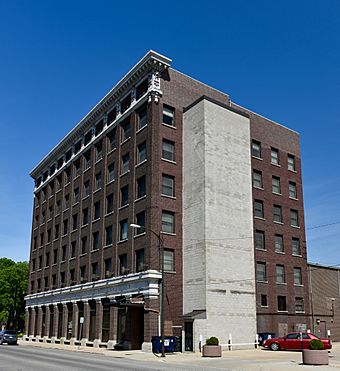Mason City Downtown Historic District facts for kids
Quick facts for kids |
|
|
Mason City Downtown Historic District
|
|
 |
|
| Location | Roughly bounded by N. 46th St., Georgia Ave., Washington Ave., and S. 2nd St., Mason City, Iowa |
|---|---|
| Area | 49.75 acres (20.13 ha) |
| Architect | Frank Lloyd Wright |
| Architectural style | Late Victorian Late 19th & early 20th century Revivals |
| NRHP reference No. | 05000956 |
| Added to NRHP | September 8, 2005 |
The Mason City Downtown Historic District is a special area in Mason City, Iowa, that is important to the history of the United States. It was added to the National Register of Historic Places in 2005. This list helps protect places that have a lot of history.
When it was added, the district had 93 important items. These included 63 buildings, one special park, and four objects that helped tell its story. There were also some newer buildings and objects that were not part of the original history. Mason City was started in 1855. It became a busy place for businesses and factories in northern Iowa. Even though trains were important, the tracks went around the main downtown area. This helped serve the factories and big stores on the edges of town. Central Park was planned when the city first started and is a key part of this historic district.
What Makes This District Special?
The Mason City Downtown Historic District shows how cities grew in the past. It has many buildings that were designed by local builders. It also features some amazing buildings created by famous architects.
Famous Buildings and Architects
Many important buildings in the district were designed by well-known architects. Here are a few examples:
- Parker's Opera House (1883) was designed by William Foster.
- The old Mason City Public Library (1904) was designed by Patton & Miller.
- The Park Inn Hotel (1909) and the City National Bank (1910) were designed by the very famous architect Frank Lloyd Wright.
- The First National Bank (1911) was designed by Liebbe, Nourse & Rasmussen.
- The MBA Building (1917) was designed by Bell & Bentley.
- The Hanford Hotel (1921) was designed by Proudfoot, Bird & Rawson.
- The YMCA (1926) was designed by Tyrie and Chapman.
- The former First Church of Christ, Scientist (1928) was designed by Clyde W. Smith.
Local architects like E.R. Bogardus and Karl Waggoner also designed buildings here. Another building, The Kirk (1903), which is an apartment building, is also listed on the National Register by itself.
Images for kids




